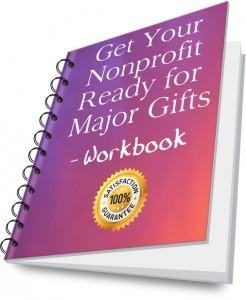
Is this how you’re making your donor feel?!
BOO!
Today is Halloween, so I’ve got some really scary stuff for you!
Don’t get too spooked. There are also a few treats.
Eight delicious goodies, in fact.
In the form of “to-do’s.”
But first… the bad news.
No bones about it, you’re scaring folks away if you’re committing any of these boo-boos!
8 Ways You’re Scaring Would-Be Supporters Away
- Your website isn’t donor-friendly.
- Your mailings aren’t easy to read and understand – quickly.
- You fail to thank promptly and personally.
- Your communication style is ego-centric.
- You fail to consider what’s in this for your donors – how they might benefit.
- You fail to qualify folks for major donor cultivation.
- You fail to update donors regularly on the impact of their philanthropy.
- All you talk about is money.
Fear not! I’ll tackle each of these mistakes one by one today, so you can fill up your sack with nothing but treats for your supporters.
1. Scary Nonprofit Websites
 Let’s begin with 9 Super Scary Nonprofit Website Mistakes from Network for Good. They suggest you avoid the following mistakes, and I heartily endorse their recommendations. In a nutshell, assure your website has:
Let’s begin with 9 Super Scary Nonprofit Website Mistakes from Network for Good. They suggest you avoid the following mistakes, and I heartily endorse their recommendations. In a nutshell, assure your website has:
- Contact information and that all staff know how to handle donor inquiries.
- Details about your nonprofit’s mission and vision that make you stand out from other nonprofits in your field.
- Updated news so you look relevant, not stale.
- User-friendly navigation so visitors can easily find what they’re looking for.
- Mobile-friendly navigation, since many folks will open your communications on their tablet or phone.
- A readily visible donation button that’s big, bold and above ‘the scroll’ and leads to a branded donation page.
- Social media links and a simple newsletter sign up that make it easy for supporters to see your content moving forward, and share with their networks.
- Visuals to illustrate your work, as attention spans are short and a picture is worth a thousand words.
- Endorsements and third party reviews. Testimonials serve as “social proof,” helping folks to believe they can trust you.
TO-DO: Review your website, determine the weaknesses, and develop a plan to address them – hopefully before year-end fundraising season kicks into high gear.
2. Scary Fundraising Appeals
![]() Too much stuff is too much stuff! Is your letter 11-point type so you can squish all your text into one page? Does your appeal lack compelling visuals? Did you leave out subheads, italics, boldface and underline to save space? Did you fail to indent paragraphs, making it difficult for your readers to enter into your copy? Did you talk about so many different programs it all became one big blur for your reader?
Too much stuff is too much stuff! Is your letter 11-point type so you can squish all your text into one page? Does your appeal lack compelling visuals? Did you leave out subheads, italics, boldface and underline to save space? Did you fail to indent paragraphs, making it difficult for your readers to enter into your copy? Did you talk about so many different programs it all became one big blur for your reader?
Did you ask for multiple actions (e.g., donate, volunteer, sign this petition, attend our event) that your donor is unable to ascertain your priority? If plodding through your appeals is a gruesome process that makes your would-be supporters want to tear out their hair, spook them and drive them away.
TO-DO: Review and edit your appeal letter so it’s reader-friendly and donor-centric.
3. Scary Acknowledgment Programs
 A sorry donor acknowledgment program will essentially poison your donors. They’ll wither away. Want to know what’s better than Halloween candy to your donor? A prompt (within 48 hours), personal (uses their name and reflects back to them the purpose of the gift and other things you know about them), powerfully impactful thank you letter.
A sorry donor acknowledgment program will essentially poison your donors. They’ll wither away. Want to know what’s better than Halloween candy to your donor? A prompt (within 48 hours), personal (uses their name and reflects back to them the purpose of the gift and other things you know about them), powerfully impactful thank you letter.
TO-DO: Put a comprehensive donor acknowledgment program in writing.
4. Scary Communications and Relationship Building
 Beware of becoming the “horseless headsman,” and check your ego at the door when it comes to your emails, newsletter and blog posts. Donors don’t care so much about your needs, but about theirs. If you want to turn your donors’ faces into smiling jack-o-lanterns be sure to make it about them. YOU can do this (not we or our organization does this). Show them how to be the person they most want to become, by telling them a story –ONE STORY – that gives them the opportunity to be the hero who bestows the happy ending.
Beware of becoming the “horseless headsman,” and check your ego at the door when it comes to your emails, newsletter and blog posts. Donors don’t care so much about your needs, but about theirs. If you want to turn your donors’ faces into smiling jack-o-lanterns be sure to make it about them. YOU can do this (not we or our organization does this). Show them how to be the person they most want to become, by telling them a story –ONE STORY – that gives them the opportunity to be the hero who bestows the happy ending.
TO-DO: Review and edit your communications (e.g., newsletter, blog, annual report, thank you letters) so they’re all about the donor.
5. Scary Relationship Building
 Think from your donor’s perspective. What’s in this for them? Everyone likes a bit of candy now and again. If you don’t think about the gifts you can give, and how your donor might benefit from building a relationship with you, then your attempts at building relationships may drive them a bit batty rather than put them under your spell. If you want to sustain giving over the long term, you’ve got to devote yourself to two things: impact (how can you show it?) and gratitude (you can’t say thank you too often or too well).
Think from your donor’s perspective. What’s in this for them? Everyone likes a bit of candy now and again. If you don’t think about the gifts you can give, and how your donor might benefit from building a relationship with you, then your attempts at building relationships may drive them a bit batty rather than put them under your spell. If you want to sustain giving over the long term, you’ve got to devote yourself to two things: impact (how can you show it?) and gratitude (you can’t say thank you too often or too well).
TO-DO: Think about the gifts of content you can offer your donors, and develop an engagement-oriented content marketing plan to deliver them.
6. Scary Major Donor Cultivation Programs
 What’s the best way to connect major donor prospects to you emotionally? Hint: It’s not jumping out from behind the bushes to scare the beejeezus out of them! Yet too often that’s exactly what we do with major donor prospects. In Once a Major Donor Always a Major Donor, Leslie Allen writes for Front Range Source about what it means to take your major donor prospect out of the regular annual giving pipeline – and all the familiar ways they have to connect with you – and unceremoniously toss them into a different pipeline with different rules. Your donors don’t know about your plans to make them a major donor. They aren’t notified when you re-categorize them. They might be up for it, but not unless you approach the transition with great care and take steps to qualify those who really want to connect with you in a more in-depth manner.
What’s the best way to connect major donor prospects to you emotionally? Hint: It’s not jumping out from behind the bushes to scare the beejeezus out of them! Yet too often that’s exactly what we do with major donor prospects. In Once a Major Donor Always a Major Donor, Leslie Allen writes for Front Range Source about what it means to take your major donor prospect out of the regular annual giving pipeline – and all the familiar ways they have to connect with you – and unceremoniously toss them into a different pipeline with different rules. Your donors don’t know about your plans to make them a major donor. They aren’t notified when you re-categorize them. They might be up for it, but not unless you approach the transition with great care and take steps to qualify those who really want to connect with you in a more in-depth manner.
TO-DO: Develop a plan to “qualify” major donor prospects before removing them from their familiar annual giving pipeline.
7. Scary Stewardship Programs
 The whole point of acquiring new gifts is renewing them.
The whole point of acquiring new gifts is renewing them.
You don’t want your hard-won donors to fade away like ghosts. Let me say that again.
The whole point of acquiring new gifts is renewing them.
You see, most first-time gifts are not repeated. You’ll lose, on average, 77% of these folks. And it costs you more to acquire them than they give you. That’s why you have to think in terms of lifetime value.
Are you committing the mistake of having a stewardship “program” that’s not really planned? If you do things “catch as catch can” that’s how your donors will feel. That’s not what you want. You want them to feel they can count on you. They want consistency. Dependability. You can’t build trust if your “strategy” appears to be all smoke and mirrors (i.e., you promised the sun, moon and stars would result from your donor’s gift, but you never actually showed them you delivered on this promise)!
TO-DO: Commit to putting a donor stewardship program in writing.
8. Scary Topic: Money
 We think money is creepy. So much so, that talking about it is still one of the biggest social taboos in our society. And when it comes to asking for money? We’re scared out of our wits! In The Heart of Effective Major Donor Development: It’s Not Money I discuss how to reframe the ask as being about something else. Which, of course, it is. It’s about impact.
We think money is creepy. So much so, that talking about it is still one of the biggest social taboos in our society. And when it comes to asking for money? We’re scared out of our wits! In The Heart of Effective Major Donor Development: It’s Not Money I discuss how to reframe the ask as being about something else. Which, of course, it is. It’s about impact.
Keep this in mind not only when you’re approaching major donors with a face-to-face appeal. Take a look at your written appeal. Is it just about money? Is your appeal generic, with the only specific being how much money you want? (e.g., “We do this, this and this… we’re the biggest and best… give us $100 so we can keep being awesome.”). There’s nothing wrong about being specific about the amount of your request; in fact, you should be specific. But the amount of your ask must be tied directly to what that sum will accomplish.
TO-DO: Talk about the distinction between philanthropy (voluntary action for the public good) and fundraising (asking as servant to philanthropy) at a board/staff meeting and/or retreat, and build a plan to make your communications all about impact.
Summary
 There’s a right and wrong way to approach everything. With donors, there’s a scary and a soothing way. There’s a scattered and a together way. If you’re all over the place, your donor doesn’t know what to expect. So they shy away from you. And then you don’t get what you’re expecting.
There’s a right and wrong way to approach everything. With donors, there’s a scary and a soothing way. There’s a scattered and a together way. If you’re all over the place, your donor doesn’t know what to expect. So they shy away from you. And then you don’t get what you’re expecting.
If you want the best results, you need a plan that avoids the aforementioned mistakes. Think of the difference in results between these two trick-and-treaters:
- Shows up with a costume, a smile and a thoughtful plan of attack that takes them through the “good” neighborhoods.
- Randomly visits a house here and there, and just scares people.
The first approach is thoughtful. People will readily recognize the asker’s intent, and happily give them the goodies they seek. The second approach is a bit unnerving. When they open the door, the would-be giver isn’t sure of this person’s intentions. Are they there to rob them? To egg their house? Plan ahead and go for what you want and need. Otherwise, you may get some lollipops and chewing gum. But I know that’s not what you really want.
BOOst Your Odds &Take the Pain out of Asking for Major Gifts!

Major Gifts from A to Z: Get all 4 volumes at a ‘Bargain Bundle’ discount.
Get the Clairification Major Gifts Playbook — a holistic approach with 4 separate Guides that work as companions or stand-alones. Have a specific area proving to be a stumbling block? Buy one or two. If you’re new to major gifts, or know you could do everything better, get ‘em all at the “Bundle Bargain” discount!
- Get Ready for Major Gifts Strategy Workbook
- Get Your Solicitors and Donors Ready for the Major Gifts Ask Strategy Workbook
- 50 Ways to Move Your Donor – Cultivation Solution Kit to Get to Yes with Finesse
- Anatomy of a Major Gifts Ask – Passion, Prepare, Practice, Pitch, Pay Attention, Persist
Most of the money – 80 – 90% — is in major individual gifts. If you’re doing everything else right, but still really aren’t touching major gifts with a 10-foot pole, then you’re working hard, not smart. Please… let me help!
Photos, in order, by hyena reality,Pansa, Rattikankeawpun,lekkyjustdoit, vectorolie. Ohmmy3d,David Castillo Dominici, debspoons, Viacheslav Zuzuan, Heavypong





